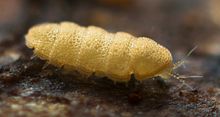Pauropoda
| Pauropoda | |
|---|---|

| |
| A eurypauropod from New Zealand
| |
| Scientific classification | |
| Domain: | Eukaryota |
| Kingdom: | Animalia |
| Phylum: | Arthropoda |
| Subphylum: | Myriapoda |
| Class: | Pauropoda |
| Orders | |
| |
| Synonyms[1] | |
| |
Pauropoda is a class of small, pale, millipede-like arthropods in the subphylum Myriapoda. More than 900 species in twelve families[2][3][4] are found worldwide, living in soil and leaf mold. Pauropods look like centipedes or millipedes and may be a sister group of the latter,[5] but a close relationship with Symphyla has also been posited.[6][2] The name Pauropoda derives from the Greek pauros (meaning small or few) and pous or podus (meaning foot), because most species in this class have only nine pairs of legs as adults, a smaller number than those found among adults in any other class of myriapods.[7][8][9]
Anatomy and ecology

Pauropods are soft, cylindrical animals with bodies measuring only 0.3 to 2 mm in length.
Pauropods live in the soil, (usually at densities of less than 100 per square metre [9/sq ft]), and under debris and
Discovery
The first pauropod species to be discovered and described was Pauropus huxleyi, found in London in 1866 by Lord Avebury.[14] He wrote of the creature:
Pauropus huxleyi is a bustling, active, neat and cleanly creature. It has, too, a look of cheerful intelligence, which forms a great contrast to the dull stupidity of the Diplopods, or the melancholy ferocity of most Chilopods.[14]'
In 1870, Packard discovered a species of North American pauropod, extending the group's range.[15]
Evolution and systematics
Only one
Pauropods are divided into two orders:
Adults in the order Tetramerocerata have a scarcely telescopic antennal stalk with four segments, six tergites, and eight to ten pairs of legs.[8] Pauropods in this order are small (sometimes quite small) and white or brownish.[20] Most species have nine pairs of legs as adults,[9][21] but adults in four genera (Cauvetauropus, Aletopauropus, Zygopauropus, and Amphipauropus) have only eight pairs of legs,[8] and adult females in the genus Decapauropus have either nine or ten pairs of legs.[17] The order Tetramerocerata has a subcosmopolitan distribution.[17]
Pauropods in the order Hexamerocerata have a strongly telescopic antennal stalk with six segments.[17] Adults in this order have twelve tergites and eleven pairs of legs.[8] The pauropods in this order are white and relatively long and large.[20] The order Hexamerocerata has a mainly tropical range.[8]
Reproduction and development
Pauropods, like all other myriapods, are gonochoric.[22] Male pauropods place small packets of sperm on the ground, which the females use to impregnate themselves.[2] The females then deposit the fertilized eggs on the ground.[23] Parthogenesis can occur in some species, especially when environmental conditions are unfavourable.[2][24][25]
The embryo goes through a short pupoid stage before the egg hatches and the first larval
Behavior and diet
Pauropods are shy of light, and will attempt to distance themselves from it.
Gallery
-
Two pauropods of the genus Eurypauropus.
References
- .
- ^ a b c d e f g h "Encyclopedia of Arkansas". Encyclopedia of Arkansas. Retrieved 2022-08-17.
- .
- ^ a b "ITIS - Report: Pauropoda". www.itis.gov. Retrieved 2024-02-28.
- ^ ISBN 978-1-4020-3182-3.
- S2CID 245468355.
- ^ "Class Pauropoda | Terrestrial Mandibulates | The Diversity of Animal Life". biocyclopedia.com. Retrieved 2024-02-28.
- ^ ISBN 9789004156111.
- ^ OCLC 1102791607.
- ^ THE PAUROPODA - Savannah River Ecology Laboratory
- ^ ISBN 978-0-12-179726-3.)
{{cite book}}: CS1 maint: multiple names: authors list (link - ^ Alcocer, Yuanxin (Amy) Yang. "Pauropoda: Characteristics, Classification & Examples". study.com.
- ^ a b "pauropod | arthropod class | Britannica". www.britannica.com. Retrieved 2022-08-17.
- ^ a b British Museum (Natural History).; History), British Museum (Natural; Bell, F. J.; Calman, W. T.; Hirst, A. S. (1910). Guide to the Crustacea, Arachnida, Onychophora and Myriopoda exhibited in the Department of Zoology, British Museum (Natural History) ... London: Printed by order of the Trustees.
- ^ Entomological Society of Washington; Washington, Entomological Society of (1943). Proceedings of the Entomological Society of Washington. Vol. 45. Washington, etc: Entomological Society of Washington.
- ^ "ITIS - Report: Hexamerocerata". www.itis.gov. Retrieved 2024-02-28.
- ^ ISSN 1875-2535.
- ^ "ITIS - Report: Tetramerocerata". www.itis.gov. Retrieved 2024-02-28.
- ^ "ITIS - Report: Pauropodidae". www.itis.gov. Retrieved 2024-02-28.
- ^ a b Sadler, Pamela (2022-01-06). "Pauropods - Reproductive Biology". GUWS Medical. Retrieved 2022-08-17.
- ISBN 978-3-540-67406-1.
- ^ Krishna (2020-10-28). "Myriapods: their Characteristics, Anatomy, Habitat, Diet, and Reproduction". ckrokill. Retrieved 2022-08-17.
- ^ a b "Class Pauropoda". keys.lucidcentral.org. Retrieved 2022-08-18.
- ^ "Pauropods: Pauropoda | Encyclopedia.com". www.encyclopedia.com. Retrieved 2022-08-17.
- ^ "Parthenogenesis - an overview | ScienceDirect Topics". www.sciencedirect.com. Retrieved 2022-08-17.
- S2CID 21401688. Retrieved 25 August 2020.
- ISBN 978-90-04-15611-1.
Further reading
- Ulf Scheller (1990). "Pauropoda". In Daniel L. Dindal (ed.). Soil Biology Guide. New York: ISBN 978-0-471-04551-9.
- Ulf Scheller (2002). "Pauropoda". In Jorge Llorente Bousquets; Juan J. Morrone (eds.). Biodiversidad, Taxonomía y Biogeografía de Artrópodos de México: Hacia una Síntesis su Conocimiento (in Spanish). Vol. III. Tlalpan, Mexico: CONABIO.





